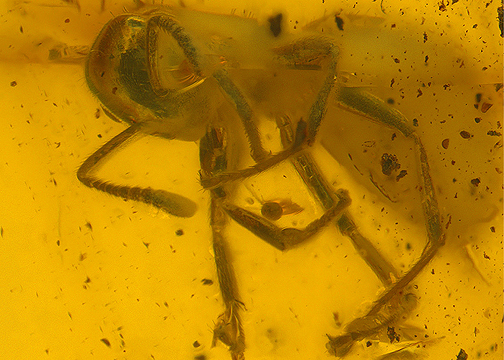Abstract
A new species of the fossil ant genus Drymomyrmex Wheeler, 1915, D. rasnitsyni sp. nov., is described from the late Eocene Rovno amber (Ukraine). This is the first find of a worker of this genus and the first record of Drymomyrmex in the Rovno amber. Based on the analysis of the morphological features of gynes and worker it is proposed to attribute Drymomyrmex to the tribe Plagiolepidini Forel, 1886.
References
- Blaimer, B.B., Brady, S.G., Schultz, T.R., Lloyd, M.W., Fisher, B.L. & Ward, P.S. (2015) Phylogenomic methods outperform traditional multi-locus approaches in resolving deep evolutionary history: a case study of formicine ants. BMC Evolutionary Biology, 15, 271. https://doi.org/10.1186/s12862-015-0552-5
- Bolton, B. (1994) Identification guide to the ant genera of the world. Harvard University Press, Cambridge, Massachusetts, London, 222 pp.
- Bolton, B. (2003) Synopsis and classification of Formicidae. Memoirs of the American Entomological Institute, 71, 1–370.
- Bolton, B. (2021) An online catalog of the ants of the world. Available from: http://antcat.org (accessed 15 January 2021).
- Carpenter, F.M. (1930) The fossil ants of North America. Bulletin of the Museum of Comparative Zoology at Harvard College, 70, 1–66.
- Czechowski, W., Radchenko, A., Czechowska, W. & Vepsäläinen, K. (2012) The ants of Poland with reference to the myrmecofauna of Europe. Fauna Poloniae, Vol. 4, (N.S.). Natura Optima Dux Foundation, Warszawa, 496 pp.
- Dlussky, G.M. (1967) Ants of the genus Formica from the Baltic amber. Paleontological Journal, 2, 69–77.
- Dlussky, G.M. (1988) Ants of the Sakhalin amber (Paleocene?). Paleontologicheskii Zhurnal, 1, 50–61. [In Russian]
- Dlussky, G.M. (1997) Genera of ants (Hymenoptera, Formicidae) from the Baltic amber. Paleontological Journal, 31 (6), 616–627.
- Dlussky, G.M. (2008) Ants of the tribe Formicini (Hymenoptera, Formicidae) from Late Eocene amber of Europe. Paleontological Journal, 42 (5), 500–513. https://doi.org/10.1134/S0031030108050055
- Dlussky, G.M., Wappler, T. & Wedmann, S. (2009) Fossil ants of the genus Gesomyrmex Mayr (Hymenoptera, Formicidae) from the Eocene of Europe and remarks on the evolution of arboreal ant communities. Zootaxa, 2031 (1), 1–20. https://doi.org/10.11646/zootaxa.2031.1.1
- Dlussky, G.M. & Fedoseeva, E.B. (1988) Origin and early stages of the evolution of the ants (Hymenoptera, Formicidae). In: Ponomarenko, A.G. (Ed.), Melovoi biotsentoticheskii krizis i rannye etapy evolyutsii nasekomykh. Nauka, Moskva, pp. 70–144.
- Dlussky, G.M. & Perfilieva, K.S. (2014) Superfamily Formicoidea Latreille, 1802. In: Antropov, A.V., Belokobylskij, S.A., Compton, S.G. & Dlussky, G.M. (Eds.), The wasps, bees and ants from the Insect Limestone (Late Eocene) of the Isle of Wight, U.K. Earth and Environmental Science Transactions of the Royal Society of Edinburgh, 104 (3–4), 410–438. https://doi.org/10.1017/S1755691014000103
- Dlussky, G.M. & Putyatina, T.S. (2014) Early Miocene ants (Hymenoptera, Formicidae) from Radoboj, Croatia. Neues Jahrbuch für Geologie und Paläontologie Abhandlungen, 272 (3), 237–285. https://doi.org/10.1127/0077-7749/2014/0409
- Dlussky, G.M. & Rasnitsyn, A.P. (2009) Ants (Insecta: Vespida: Formicidae) in the Upper Eocene amber of Central and Eastern Europe. Paleontological Journal, 43 (9), 1024–1042. https://doi.org/10.1134/S0031030109090056
- Donisthorpe, H. (1920) British Oligocene ants. Annals and Magazine of Natural History, (9), 6, 81–94. https://doi.org/10.1080/00222932008632412
- Donisthorpe, H. (1943) A list of the type-species of the genera and subgenera of Formicidae. (Conclusion). Annals and Magazine of Natural History, (11), 10, 721–737. https://doi.org/10.1080/03745481.1943.9728055
- Emery, C. (1925) Hymenoptera, Fam. Formicidae, subfam. Formicinae. In: Wytsman, P. (Ed.), Genera Insectorum. Fasc. 183. Bruxelles [= Brussels], 302 pp.
- Heer, O. (1850) Die Insektenfauna der Tertiärgebilde von Oeningen und von Radoboj in Croatien. Zweiter Theil: Heuschrecken, Florfliegen, Aderflüger, Schmetterlinge und Fliegen. Wilhelm Engelmann, Leipzig, vi + 264 pp.
- Hong, Y.C. (2002) Amber insects of China. Beijing Scientific and Technological Publishing House/Henan Scientific and Technological Publishing House, 651 pp.
- LaPolla, J.S. & Greenwalt, D.E. (2015) Fossil ants (Hymenoptera: Formicidae) of the Middle Eocene Kishenehn Formation. Sociobiology, 62, 163–174. https://doi.org/10.13102/sociobiology.v62i2.163-174
- Perkovsky, E.E. (2016) Tropical and Holarctic ants in Late Eocene ambers. Vestnik Zoologii, 50 (2), 111–122. https://doi.org/10.1515/vzoo-2016-0014
- Radchenko, A.G. & Dlussky, G.M. (2018) Ants of the genus Fallomyrma Dlussky et Radchenko (Hymenoptera, Formicidae, Myrmicinae) from Late Eocene European ambers. Paleontological Journal, 52 (2), 155–163. https://doi.org/10.1134/S0031030118020107
- Radchenko, A.G., Perkovsky, E.E. & Vasilenko, D.V. (2021) Formica species (Hymenoptera, Formicidae) in late Eocene Rovno amber. Journal of Hymenoptera Research, 82, 237–251. https://doi.org/10.3897/jhr.82.64599
- Scudder, S.H. (1877) Appendix to Mr. George M. Dawson’s report. The insects of the Tertiary beds at Quesnel. Report of Progress. Geological Survey of Canada, 1875–76, 266–280.
- Steinbach, G. (1967) Zur Hymenopterenfauna des Pliozäns von Willershausen/Westharz. Bericht der Naturhistorischen Gesellschaft zu Hanover, 111, 95–102.
- Ward, P.S., Blaimer, B.B. & Fisher, B.L. (2016) A revised phylogenetic classification of the ant subfamily Formicinae, with resurrection of the genera Colobopsis and Dinomyrmex. Zootaxa, 4072, 343–357. https://doi.org/10.11646/zootaxa.4072.3.4
- Wheeler, W.M. (1915) The ants of the Baltic amber. Schriften der Physikalisch-ökonomischen Gesellschaft zu Königsberg in Preußen, 55 (2), 1–142.
- Wheeler, W.M. (1929) The identity of the ant genera Gesomyrmex Mayr and Dimorphomyrmex Ernest André. Psyche, 36, 1–12. https://doi.org/10.1155/1929/71489
- Wilson, E.O. (1985) Ants from the Cretaceous and Eocene amber of North America. Psyche, 92, 205–216. https://doi.org/10.1155/1985/57604


